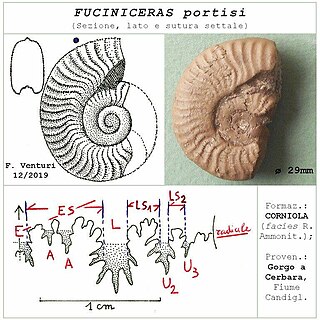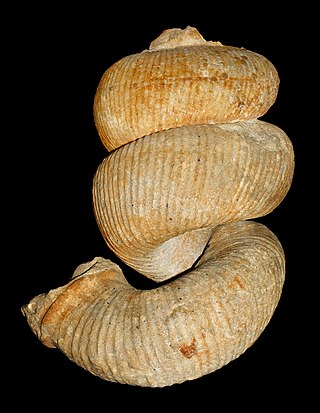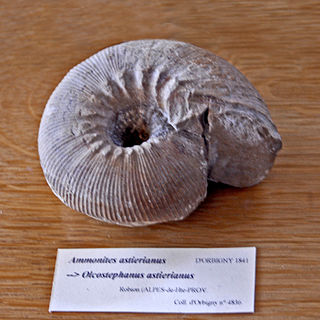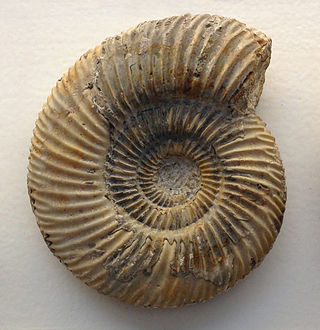
Acanthohoplites is an extinct genus of ammonites in the family Parahoplitidae that lived in the Aptian and Early Albian stages of the Early Cretaceous.

Arnioceras is an extinct genus of large, evolute, discoidal ammonite from the Lower Jurassic. The shell is normally coiled so that all whorls are exposed. Sides bear strong sharp ribs that are straight until reaching the ventrolateral edge where they swing forward and fade. The rim (venter) is keeled and free of grooves.

Fuciniceras is an extinct cephalopod genus included in the ammonoid family Hildoceratidae,, that lived during the Pliensbachian stage of the Early Jurassic. The shell of Fuciniceras is generally small, evlute, and strongly ribbed.
Euaptetoceras is an evolute hildoceratoid ammonite from the lower Middle Jurassic, included in the family Hammatoceratidae and the subfamility Hammatoceratinae. The genus may be a junior synonym for Eudmetoceras of Buckman, 1920.

Durotrigensia is a genus of ammonites (Ammonitida) in the perisphinctoid family Parkinsoniidae.
Okribites is a perisphinctoidean ammonite from the middle Jurassic of the Republic of Georgia. It is assigned to the family Parkinsoniidae, a group of strongly but evenly ribbed evolute, commonly discoidal ammonites. Parkinsonia is a related genus.
Metrolytoceras is an extinct cephalopod genus that lived during the Middle Jurassic, characterized by a planispiral evolute shell with smooth middle and outer whorls, flat sides and simplified sutures.
Megasphaeroceras is an ammonite genus included in Sphaeroceratidae, a family of ammonoid cephalopods characterized by their spheroidal shells with markedly eccentric coiling, fine ribbing, and complex sutures, known from the Bajocian.

Hyperlioceras is an extinct genus of cephalopod included in the ammonitid family Graphoceratidae that lived during the Bajocian stage of the Middle Jurassic. The type species is Hyperlioceras discites
Graphoceras is an extinct ammonite genus included in the hildoceratacean family Graphoceratidae that lived during the Aalenian and Bajocian stages, Middle Jurassic in what is now Europe, north Africa, and Iran.

Bostrychoceras is a genus of heteromorph ammonite from the family Nostoceratidae. Fossils have been found in Late Cretaceous sediments in Europe and North America.

Exiteloceras is an ammonite genus from the Late Cretaceous.

Plethodus is an extinct genus of prehistoric ray-finned fish. It is the type genus of the family Plethodidae.
Petitclercia is a genus of molluscs from the strigoceratid subfamily Disticocratinae which are included in the ammonitid superfamily Haplocerataceae. Petitclercia, named by Rollier, 1909.

Craspedites is an ammonoid cephalopod included in the Perisphinctoidea that lived during the Late Jurassic and Early Cretaceous, found in Canada, Greenland, Poland, and the Russian Federation.

Calycoceras is an extinct genus of cephalopods belonging to the subclass Ammonoidea and family Acanthoceratidae that lived during the Cenomanian stage of the Late Cretaceous, 100-94 Mya. Their shells had ornate ribs.

Lytoceras is an ammonite genus that was extant during most of the Jurassic and Cretaceous periods, and is the type genus for the family Lytoceratidae. These cephalopods were fast-moving nektonic carnivores.

Olcostephanus is an extinct ammonoid cephalopod genus belonging to the family Olcostephanidae. These fast-moving nektonic carnivores lived during the Cretaceous, from the upper Valanginian to the lower Hauterivian age.

Parkinsonia is a genus of ammonites belonging to the family Parkinsoniidae.

Trachyceras is a genus belonging to the extinct subclass of cephalopods known as ammonites. Specifically it belongs in the order Ceratitida. They are distributed in Afghanistan, Bosnia and Herzegovina, Canada, China, Germany, Hungary, India, Indonesia, Italy, the Russian Federation, Slovenia, United States.














